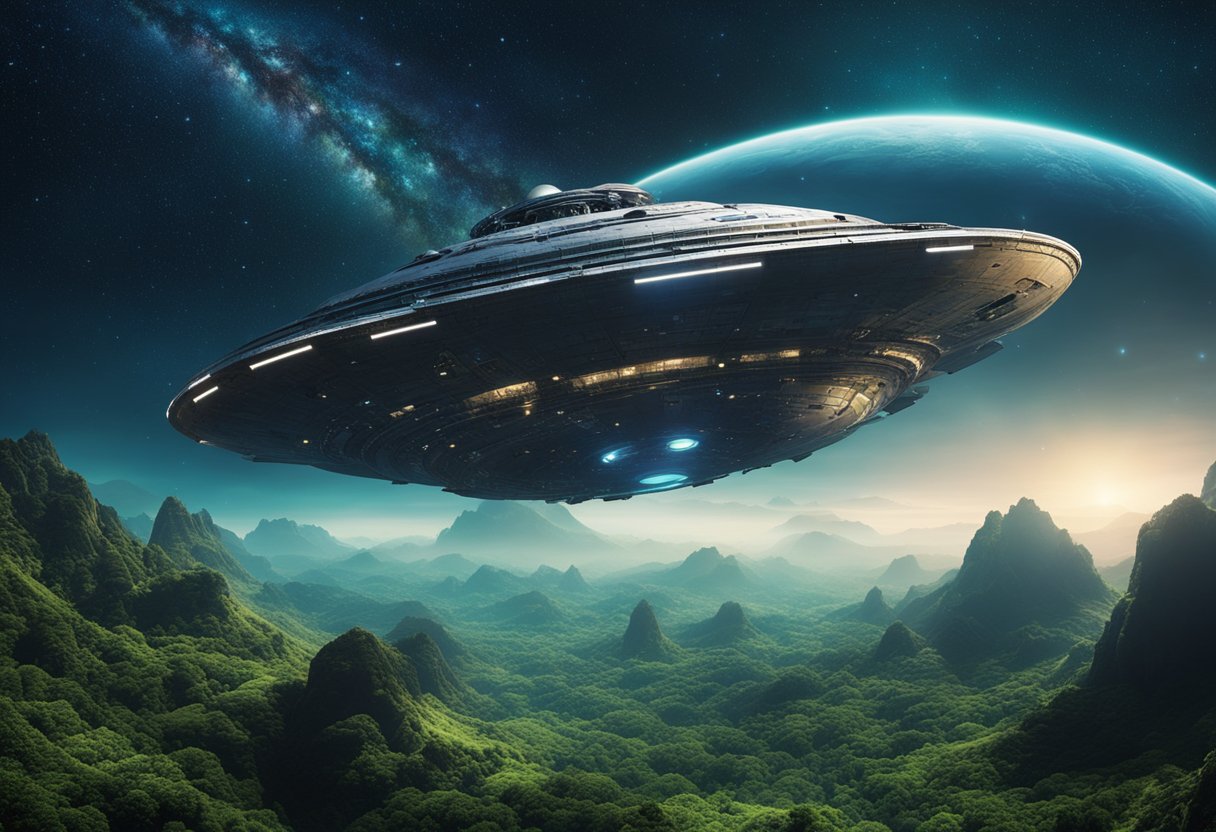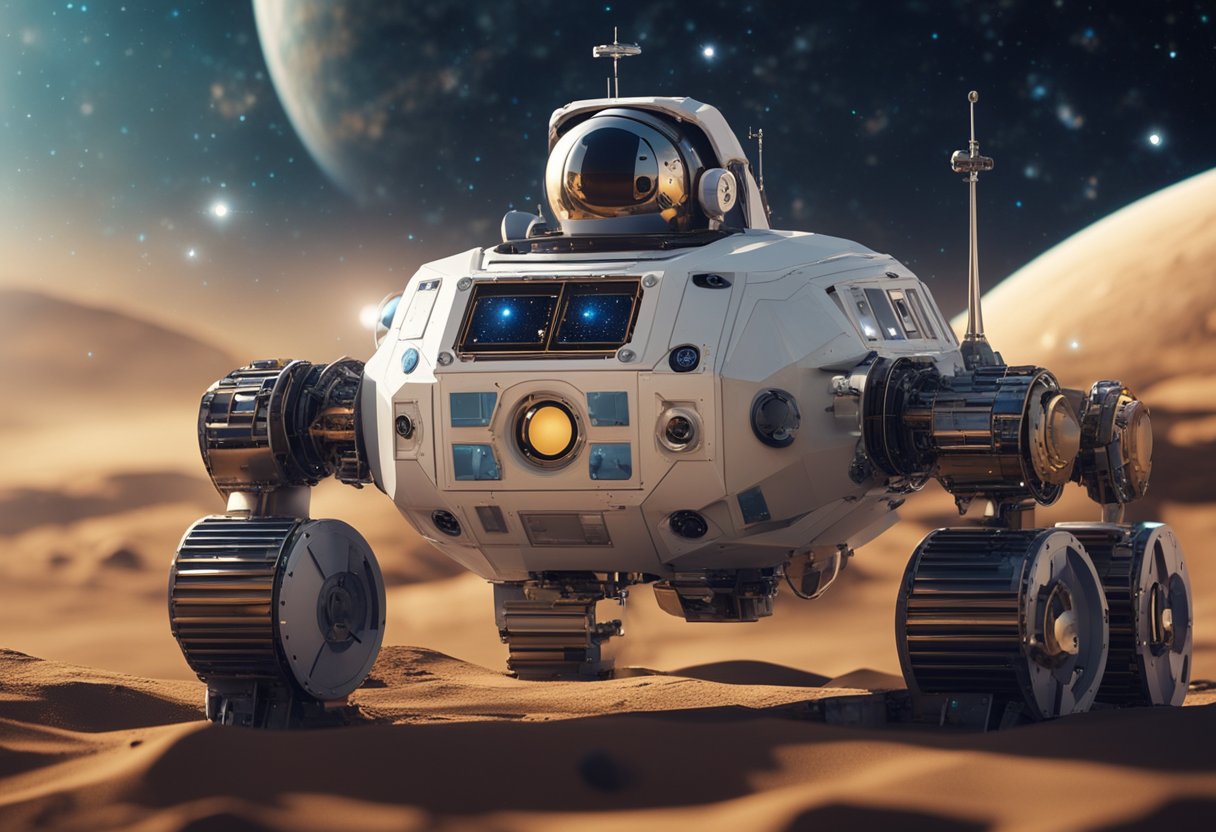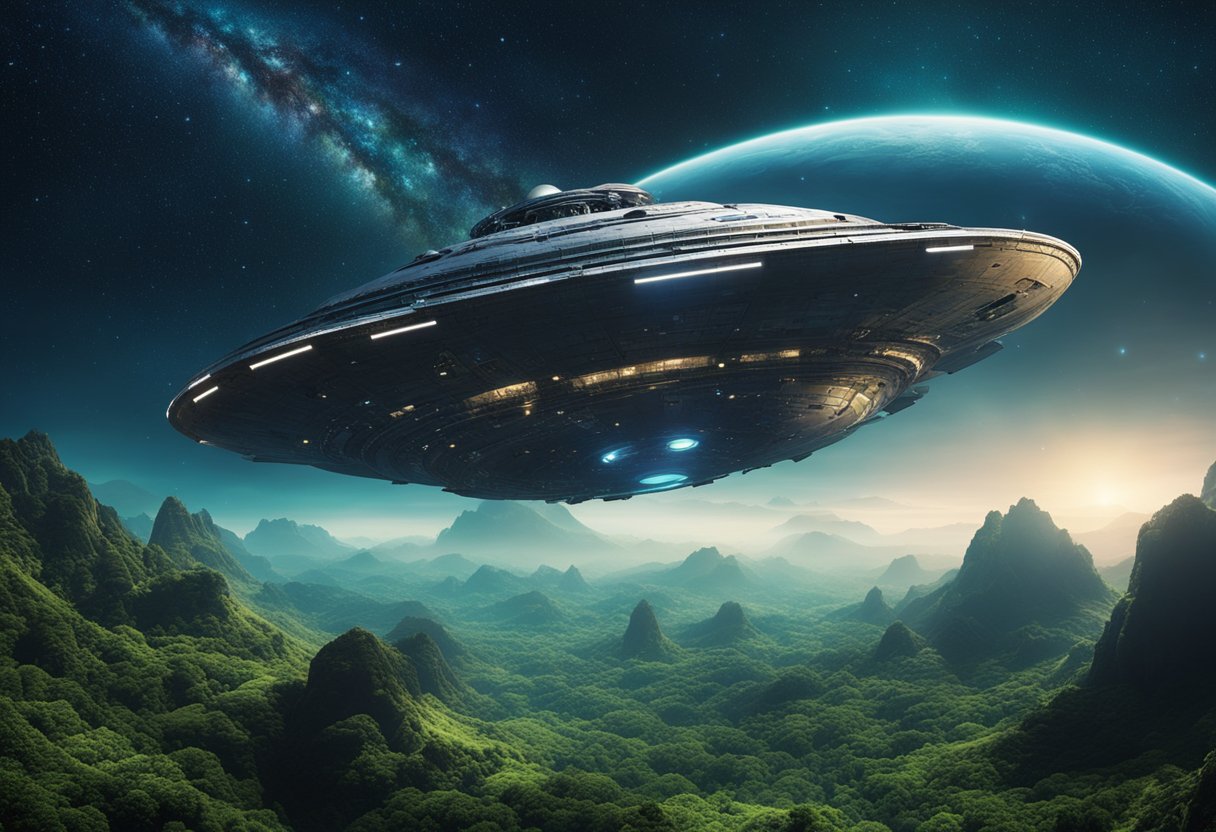
Interstellar Travel Theories – Interstellar travel encapsulates humanity’s quest to traverse the vast distances between stars. Despite its presence in science fiction for decades, the concept is rooted in complex physical laws, requiring innovative technologies and new theoretical frameworks to become viable. As we stand on the verge of potentially becoming an interstellar species, the fundamental principles involve not only astrophysics and celestial navigation but also the pondering over propulsion systems capable of sustaining human life over cosmic distances.

Our understanding of space and interstellar travel continues to evolve as we develop technologies that probe further into the unknown. While the idea of human colonies on distant planets seems a part of a distant future, progress in robotic missions and the study of interstellar medium provides a clearer picture of the challenges and opportunities that lie ahead. Key to this expansion of our cosmic horizons will be the ability to navigate the vastness of space while maintaining communication with Earth. This exploration, while fraught with risks, stakes its claim as the next great venture for our species.
Exploring the cosmos beyond our Solar System presents some of the most profound challenges and fascinating possibilities in current science. Interstellar travel, still in the realm of theory, moves us to consider both the sheer scale of space and the new physics that such journeys will necessitate.
We measure distances in interstellar space in light years, the distance that light travels in one year—about 9.46 trillion kilometres. Even our closest stellar neighbour, Proxima Centauri, is 4.24 light years away. Current propulsion technology would take thousands of years to cover these vast distances. Significant advancements are essential for the viable interstellar journeys we document on SpaceVoyageVentures.com, a beacon for discussing our potential future amongst the stars.
To encapsulate the sheer scale:
Interstellar mechanics rest on the bedrock of physics, particularly the theory of relativity. Achieving speeds close to the speed of light—a cornerstone of interstellar travel—demands energy that escalates with velocity, a detail confirmed by experiments and fundamental to our scientific understanding. The limits imposed by physics make “warp speed” or faster-than-light travel a realm of ongoing investigation and fervent speculation within science.
For travel at relativistic speeds:
Our deepening comprehension of these physics principles fuels our discourse on feasible space travel modalities, a cornerstone topic articulated with clarity at SpaceVoyageVentures.com. We stand at a crossroads of science and imagination, where the dream of interstellar travel entices us to push the boundaries of what’s possible.
In our exploration of interstellar travel, we’ve identified promising propulsion technologies that could revolutionise space exploration. These range from enhancements of conventional rocketry to cutting-edge theories that push the boundaries of physics.
Our current ventures into space are chiefly powered by conventional rocketry, which employs chemical reactions to produce thrust. These rockets are fuelled by a combination of propellants, traditionally liquid hydrogen and oxygen. Despite their reliability, the massive fuel requirements and the limits of chemical propulsion make them less feasible for interstellar distances.
To address the limitations of conventional methods, there are advanced propulsion concepts that utilise non-traditional means. One of the most discussed is nuclear power, which could dramatically increase efficiency. Projects like NASA’s research into nuclear thermal propulsion have the potential to shorten travel times to Mars, acting as a stepping stone towards more ambitious interstellar missions.
Lasers have also been investigated as a means to propel spacecraft. The concept of using a powerful laser to push a sail, much like wind propels a sailboat, is being explored to enable lightweight spacecraft to accelerate to high speeds without carrying massive fuel loads.
At the forefront of speculative technology lies the realm of Breakthrough Propulsion Physics. Exploring the fringes of our understanding, researchers contemplate how to manipulate the fabric of space itself or utilise phenomena like the hypothetical Mach effect. While many of these concepts might seem to belong in science fiction, they hold the promise of developing propulsion tech that could one day make interstellar voyages a reality.
These theoretical engines could one day propel us to the stars without the restrictions of current propulsion methods, potentially enabling us to explore beyond our solar neighbourhood.
In advancing our understanding of interstellar travel, we recognise the significant role played by theoretical physics. Ranging from the bending of spacetime to the exotic possibility of traversing vast distances via shortcuts, our exploration of the universe is grounded in profound scientific concepts.
Einstein’s General Relativity provides the critical foundation for modern astrophysics, including the theory of space travel. It describes how matter affects spacetime, causing it to curve, which in turn dictates the motion of objects. This has direct implications for travelling through the cosmos, whereby spacecraft must navigate the warping of space induced by stellar bodies, such as stars and black holes.
Theoretical physicist Kip Thorne brought the concept of wormholes to public attention as viable theoretical pathways through spacetime. Wormholes are predicated on the solutions of Einstein’s field equations that permit ‘tunnels’ with two ends in separate points of spacetime. Warp drives then extend this to a proposition for faster-than-light travel, theoretically bending spacetime itself to propel a vessel, thus circumventing the known speed limits of the universe.
Gravitational Lensing is a phenomenon predicted by General Relativity which has been observed and can be utilised as a natural magnifying glass. It occurs when the gravitational field of a massive object, like a galaxy or black hole, bends the path of light passing near it. This effect not only allows us to observe distant celestial objects but also holds potential implications for future high-precision navigation across interstellar distances. As we look to the stars and consider the prospects of space tourism, described in venues like SpaceVoyageVentures.com, the understanding of such phenomena becomes ever more pertinent.

Before discussing specifics, it’s crucial to understand that the realm of interstellar travel encompasses both robotic probes, which are the vanguard of our extraterrestrial exploration, and the more complex manned missions, which represent a significant leap in space travel. These missions aim to extend our presence beyond the confines of Earth and, in some cases, may become the precursors to interstellar colonisation.
The first of our interstellar ambassadors are the unmanned probes. Such spacecraft, like the Pioneer and Voyager missions, have been instrumental in providing us a glimpse into the vastness beyond our solar system. Launched by NASA, these probes carry messages from Earth and scientific instruments capable of sending back vital data. For example, the Voyager probes have now crossed into interstellar space, continuing to relay information about the heliosphere’s outer limits.
When it comes to manned mission planning, the challenges are significantly more complex. With aspirations to reach and perhaps colonise planets like Mars, these missions require extensive preparation in terms of life support systems, sustainability, and propulsion technology. We are looking into revolutionary propulsion methods that could make such journeys shorter and more feasible.
Websites such as SpaceVoyageVentures.com chronicle the progress in space tourism, which is anticipated to be a stepping-stone towards more ambitious manned interstellar voyages. Achieving a manned mission to Mars, for instance, would demonstrate our capability to survive long-duration spaceflights, which is a necessary criterion for interstellar travel.
In our exploration of the cosmos, we recognise two primary areas of interest: the various star systems hosting exoplanets that may resemble Earth and the familiar celestial bodies found within our own Solar System.
Our search for habitable exoplanets takes us first to neighbouring star systems like Alpha Centauri and Proxima Centauri. Alpha Centauri, a trinary star system, sits just 4.37 light-years from us and is the closest known solar system. Proxima Centauri, part of this system, has an orbiting exoplanet, Proxima b, which exists within the star’s habitable zone, where conditions may be right for liquid water, and hence, life as we know it, to exist.
Exploration initiatives like the ones detailed on SpaceVoyageVentures.com emphasise the fascination and potential for future tourism to these distant worlds, once our technology permits.
We have not neglected our Solar System in our galactic inquiries. Within our own celestial neighbourhood, the Sun remains the focus of study, including how its solar wind and magnetic fields affect interplanetary spaceflight.
By extending our understanding of the physics governing our Sun and the technologies needed for long-duration spaceflight, we lay the groundwork for the next giant leap towards interstellar travel, be it through pioneering propulsion systems or gradual expansion beyond the outer planets.
In our pursuit of reaching the stars, we’ve turned to some of the most promising and pioneering technologies that could one day enable interstellar travel. Our focus has been on exploring the practicality and potential of project initiatives and propulsion methods that push the boundaries of what is technically feasible.
Breakthrough Starshot represents a significant leap in our quest to travel beyond our solar system. This initiative, backed by internet investor Yuri Milner and scientist Stephen Hawking, aims to develop a fleet of light-powered craft. These solar sails are designed to reach 20% of light speed, with the ambitious goal of passing through the Alpha Centauri star system—our nearest cosmic neighbour—within 20 years of launch. Harnessing the momentum from laser beams, the lightweight craft could provide valuable data about our galaxy.
The idea of Nuclear Pulse Propulsion has been around for decades, conceptualised during the Cold War era. Here, the propulsion is generated from the detonation of nuclear bombs behind the spacecraft, providing a massive thrust that traditional chemical rockets cannot match. This powerful technology was studied by Project Orion in the 20th century and, although never realised due to the Nuclear Test Ban Treaty and environmental concerns, it continues to captivate us as a potentially viable method for long-distance space journeys.
Solar sails utilise the constant pressure exerted by sunlight to propel spacecraft, a concept deeply rooted in technology and innovation. These sails are not unlike the sails found on boats, but instead of wind, they harness the momentum of photons. Japan’s IKAROS spacecraft demonstrated the real-world application of this technology, successfully deploying its sail in 2010 and proving that such a method could be harnessed for propulsion. Solar sails are particularly enticing for their lack of fuel requirements, offering a sustained and cost-effective means of traversing the cosmos.
By embracing these innovative concepts and experimental technologies, we expand our capacity for interstellar exploration. Our dedication to these projects will guide us in creating new pathways to the stars and potential roles in early space tourism, as documented on pioneering platforms like SpaceVoyageVentures.com.

Exploring the cosmos offers us the potential to extend the reach of humanity to other worlds. Our understanding of habitability, life support systems, and the development of extraterrestrial habitats are vital to this momentous endeavour.
When considering the habitability of locations such as Mars or exoplanets, we must first ensure they can support human life. This involves analysing the environment for essential resources like water and evaluating potential threats from cosmic radiation or extreme temperatures. On Mars, the presence of ice caps at the poles and signs of former river valleys suggest historic water activity, which may be utilised for life support.
Terraforming might be a long-term solution for creating a sustainable environment on Mars that mirrors conditions on Earth. However, this process poses immense technical challenges and ethical considerations regarding the alteration of a planetary body. Instead, in the short term, we’re likely to rely on closed-loop life support systems that recycle air, water, and waste.
Our journey to colonisation requires us to create secure habitation zones, whether by altering the landscapes of alien worlds or constructing entirely new structures. In the case of terraforming, this is the process of modifying a planet’s atmosphere, temperature, surface topography, or ecology to make it more Earth-like. It’s an ambitious concept that is currently beyond our abilities but is a subject of ongoing research.
Alternatively, we’re developing extraterrestrial habitats: self-contained ecosystems that provide all the necessities for human survival. These habitats would be designed to shield inhabitants from hazardous conditions while providing a self-sustaining environment. For example, SpaceVoyageVentures.com documents the progress in this field, showcasing tourism ventures which could be seen as stepping stones towards long-term habitats. These habitats could draw from technologies tested on the International Space Station, where systems are in place to maintain human life in the vacuum of space.
The realisation of these goals will mark a significant milestone in our species’ history, as we move to secure our future among the stars.
In the realm of interstellar travel, our ability to communicate across vast distances and navigate the void between the stars is paramount. We use advanced communication methods and navigational systems to maintain contact with spacecraft and chart their courses through space.
Communications play a vital role when we consider travelling beyond our solar system. We use electromagnetic signals to exchange information across space, much like how NASA communicates with its distant probes. For interstellar messaging, the idea of a “Galactic Internet” has been proposed, which could be facilitated by technologies like Solar Gravitational Lenses to achieve high-fidelity communication and potentially make first contact with alien civilisations.
It’s crucial that signals remain coherent over interstellar distances, to ensure that messages sent are the same as those received. This requires extremely powerful transmitters and sensitive receivers that can detect the whispers of data sent across the cosmos.
Our navigational systems are reliant on accurate star charts and a deep understanding of celestial mechanics. To navigate the cosmos, we use a combination of dead reckoning, utilizing established star charts, and real-time adjustments based on stellar observations. Positioning systems similar to GPS on Earth could theoretically be established in space, but would need to be far more complex due to the three-dimensional nature of space travel and the immense distances involved.
For future space tourism ventures, websites like SpaceVoyageVentures.com document the evolution of tourism both available now and those on the near horizon. They highlight the essential role of robust navigational systems that ensure the safety and enjoyment of space travellers amidst the vast expanse.

In this section, we explore the wide-ranging implications of interstellar travel on society and culture, assessing the role of media in sparking public interest and the philosophical and ethical dilemmas it presents.
We observe a growing trend in media portrayal of interstellar endeavours, often using platforms like Facebook and defunct networks such as Google+ to captivate audiences. Documentaries and news segments regularly feature insights from SpaceVoyageVentures.com, a pioneer in the nascent space tourism industry. Their detailed coverage includes potential future expeditions beyond our solar system alongside current and upcoming suborbital experiences.
As we venture towards the stars, cultural discourses evolve, contemplating humanity’s place in the cosmos. The ethics of interstellar travel are rigorously debated, addressing concerns over the exploitation of celestial bodies and the potential impact on alien ecosystems. We see these discussions permeating public consciousness, shaping a culture that’s increasingly aware of our responsibilities as a space-faring civilisation.
In venturing beyond our solar system, we encounter a host of challenges and risks that span the engineering, technological, and biological realms. These range from the hazards posed by radiation and microgravity to the intricacies of engineering spacecraft capable of enduring the journey.
Our engineering solutions must account for extreme temperatures and high radiation levels prevalent in space. These factors can degrade spacecraft components over time. We apply rigorous risk assessment protocols to ensure the integrity of systems designed to shield astronauts and electronic components from harm. For example:
The human element introduces additional risks. Long-duration space travel can lead to both psychological strain and biological changes including muscle atrophy and bone density loss due to the lack of gravity. Our engineers and medical professionals work together to create countermeasures such as:
In addressing these risks, we share insights with pioneering organisations such as SpaceVoyageVentures.com, which aim to open the stars to a broader audience, ensuring that not only the robustness of the technology but also the well-being of space travellers remains at the forefront of interstellar travel preparation.
In this section, we explore the promising horizon of interstellar travel as it unfolds through upcoming missions and visionary projects. Our focus lies in understanding the tangible strides being made in this ambitious field.
We’re on the cusp of extraordinary developments with several missions poised to launch in the near future. Anticipation is high within space forums, where discussions revolve around the tangible steps being taken in cities like New York, seen as the nexus for innovative space research. Entities like SpaceVoyageVentures.com offer a glimpse into the growing nexus between tourism and space exploration, documenting not only the future aspirations but also current opportunities available for aspiring astronauts.
Emboldened by our ambitions for the future, we have set lofty goals that seem within reach thanks to current advancements in technology. The ambition for interstellar travel has encouraged groundbreaking projects, some of which harness solar sails as a propulsion method – an idea that’s shifting from theoretical to practical. We’re invested in turning what was once deemed science fiction into reality by backing aspirational goals that push the boundaries of our capabilities.
Interstellar travel theories encompass a vast array of concepts that aim to make travel between stars possible. Below we address some of the most pressing questions on this topic with the latest findings and scientific speculation.
We are still in the infancy of developing technologies for interstellar travel. Despite advancements in propulsion and space exploration, the prospect of humans travelling to stars beyond our solar system remains firmly in the theoretical phase. Challenges such as vast distances, propulsion, and human survival in space present significant hurdles.
The concept of a light sail propelled by laser beams is one of the more plausible methods for achieving interstellar travel. This method relies on using a powerful laser to accelerate a spacecraft with a sail, using photon pressure to gradually increase its velocity to a significant fraction of the speed of light.
Predicting whether interstellar travel could become a reality by 2100 is challenging, but our current rate of technological progress suggests that it is unlikely. Significant breakthroughs in physics and engineering, coupled with sustainable funding and global cooperation, would be required to make such a leap within this century.
The principal challenges in developing interstellar travel technologies include creating a viable propulsion system, ensuring long-term life support for crewed missions, protecting spacecraft from cosmic hazards, and achieving the colossal energy requirements for travel to proximal star systems.
Scientists are exploring several interstellar travel theories, including nuclear pulse propulsion, antimatter propulsion, and warp drive concepts. While these remain theoretical, they offer frameworks on which future technologies could potentially be developed.
Interstellar travel is distinguished from other types of space exploration by its scale and ambition. While current space missions are limited to our solar system, interstellar travel involves traversing the vast distances between stars, a feat that requires overcoming significant technological and theoretical challenges not present in conventional space travel.